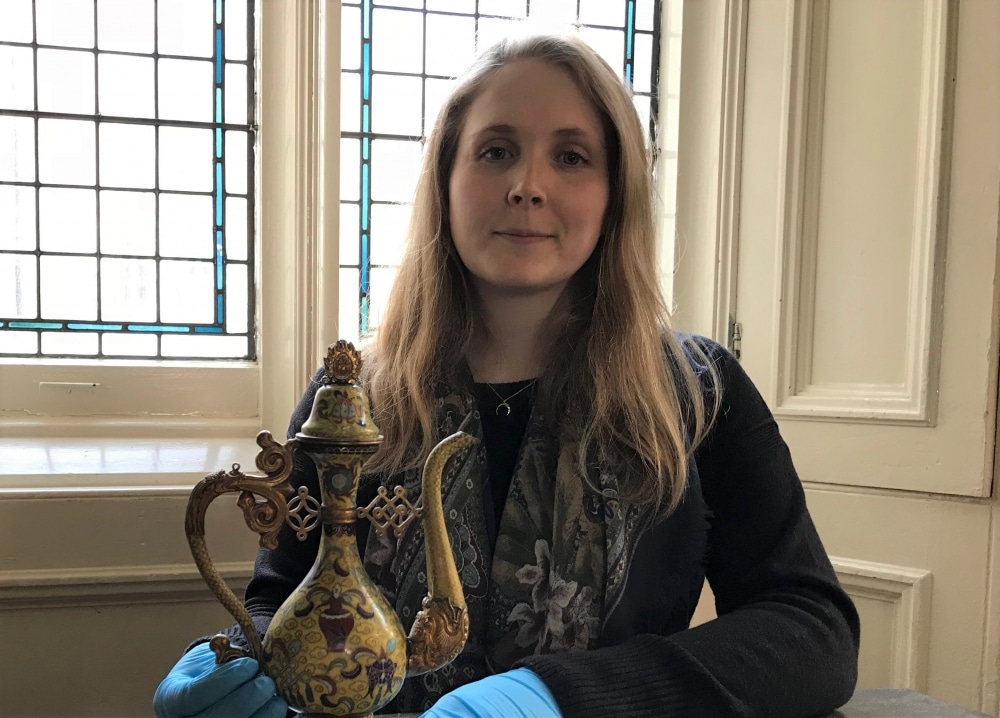Naomi Collick, the official curator at Chiddingstone Castle, absolutely loves her job.
The graduate, who has been in the role for the past two years, says that after studying Japanese and Buddhist art at university, getting the opportunity to oversee the numerous and unique historical collections of Denys Eyre Bower, the historical property’s rather eccentric former owner, is a ‘dream’.
“It was always my dream to be able to work in a museum, so I was incredibly lucky to find this role and this collection,” she says.
There are a number of special rooms dedicated to various collections, including Egyptian, Stuart and Jacobite ones as well as an impressive Japanese one.
Naomi says Eyre Bower was a prolific artefact collector – despite the fact he rarely travelled.
“The collections here are so eccentric and varied. I love being able to write and talk to people about the things I am most interested in. I really enjoy giving guided tours and writing our Object of the Month posts on our website.
“In a large museum, a curator would normally work with a team of people, including conservators, exhibition designers and other specialists. Here we are a small team and I am the only staff member who focuses on the collections.”
Naomi says this has given her the opportunity to work on some really interesting projects, such as co-ordinating loans and organising conservation work.
“We are an independent museum which receives no public funding, so I have had to think of creative ways to renew displays and work on other projects with a very small budget!”
One of these has been to launch a series of special events running throughout 2020 that celebrate Chiddingstone Castle’s link to Japan in the year the Olympics are being held in Tokyo. The first is a Zen Retreat Day on Saturday February 1.
“The Zen Retreat Day is an opportunity to bring together local practitioners and experts in mindfulness and wellbeing to offer a refreshing start to our 2020 Year of Japan programme,” explains Naomi. “Nature, meditation, and mindful living are very important to Japanese Zen Buddhism.
“Zen practices appealed to Samurai warriors, who dedicated themselves to mental and physical discipline.
“We have many objects which belonged to the Samurai in our collection.
“It’s also an opportunity to give our visitors the chance to enjoy mindful practices inspired by Zen in our grounds. This is a wonderful way to connect people with our collections, Japanese culture, and have a healthy start to the new year.”
The day will also comprise sessions of wild yoga and forest bathing – also known as Shinrin Yoku. The latter doesn’t actually require a swimsuit or any water as it involves walking around mindfully and appreciating the natural surroundings.
And there will be a talk on Toyohari acupuncture – a practice which focuses on listening to your body rather than using needles or other treatments. Plus there will be lots of food and wellness advice available.
“The day will begin with an introduction to Zen Buddhism and its link to Japanese art and culture, and our Japan Room will be open throughout the day for people to view the artefacts,” continues Naomi.
“There are approximately 800 objects in the Japanese collection, and around two thirds are lacquerware.”
Denys Eyre Bower, who was born in 1905 and died in 1977, was the last private owner of the castle, and acquired his collections over his lifetime. He particularly focused on Japanese objects during the 40s and 50s, and bought all of his objects from auctions and dealers in the UK.
“Japanese objects were very popular in the late 19th century and were bought by collectors and owners of large country homes,” says Naomi.
“In the mid-20th century, however, they had fallen out of fashion, and as Denys had an eye for a bargain he benefited from sales of the contents of wealthy country homes.
“He was skilled at spotting objects that other people overlooked, and usually collected pieces if he liked the look of them. He could see that they were well made rather than coveted for their popularity. As a result, the Japanese collection is eclectic but includes some very rare and high quality objects.”
Naomi says that Eyre Bower’s passion for all things Japanese stemmed from childhood as his father collected many East Asian works of art: “In particular, his father owned Chinese porcelain. He was also drawn to the craftsmanship and visual impact of Japanese objects. We have a number of photographs in the archive of him proudly showing off items from his Japanese collection, including a giant Samurai sword, which was quite possibly made specifically to impress Western tourists!”
Would Naomi say there is one particular highlight of the collection?
“Yes, it is what is known as the ‘Chiddingstone Casket’ – a rare, small, 17-century Japanese lacquer casket or jewel box.
“It was part of a small group of very high quality lacquer boxes made for export to the West. It is rare because it is shaped like a European building but covered in intricate Japanese lacquer designs in gold, silver, and cut shell. The most expensive and complicated lacquer techniques were used for the decoration.”
And does she have a personal favourite?
“I would say the life-size models of animals and insects expertly carved in iron.
“Using cleverly concealed links and pins, the animals were made to be fully movable. The most amazing is a large dragon which has rows of separately linked scales.
“They were made by Samurai armourers during the peaceful 17th-19th centuries, when they did not have to make as many suits of armour, so they instead showed off their metalworking skills with these decorative animals.”








